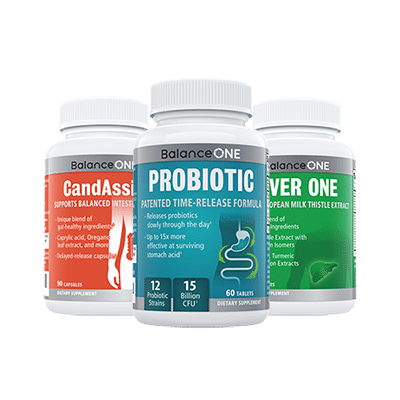Yeast Infections In Men: Causes, Symptoms & Treatment

We usually think of Candida and yeast infections as “women’s problems”. True, Candida albicans is a yeast and women are much more likely to suffer from yeast infections than men.
But guess what, men are not exempt! Candidiasis affects men, too. It can cause a nasty, painful rash that is also referred to as thrush, Candida, candida balanitis, candidiasis, or moniliasis.
Interestingly, Candidiasis was actually first discovered by a man. A university lecturer called Bernhard von Langenbeck identified Candida albicans overgrowth in 1839. Mr. Langenbeck found that although Candida albicans can live naturally on the skin without causing any problems, it had the potential to grow out of control, just like it can in the gut.
Table Of Contents
What is Candida Overgrowth?
Candida albicans is a natural yeast that lives in small amounts in the mouth and gut of both men and women. In women, Candida also lives in the vagina, which is why women are more prone to the problems it can cause. Candida albicans is the most common cause of female and male yeast infections.
Intestinal Candida overgrowth may happen if the balance of good and bad bacteria in the gut is disrupted, allowing for pathogens and fungal cells to develop more freely. This imbalance of gut microorganisms is usually referred to as dysbiosis. Dysbiosis can result after a course of antibiotics, which tend to kill off much of the good bacteria needed to keep the bad under control. Stress, medications, diet, pollution, and certain illnesses can also cause dysbiosis. Men are affected by these factors as much as women.
An intestinal Candida overgrowth is often seen at the same time as external yeast infections in men or women. By treating the intestinal overgrowth, and eliminating the factors that caused it in the first place, you can often get rid of both your gut problems and your external yeast infection.
Candida Symptoms In Both Men And Women
It must be remembered that yeasts love any kind of warm, moist body area – and both men and women have plenty of these! That’s why yeast tend to proliferate in external areas like the mouth, nails, vagina, armpits, between the toes, under the breasts, in the foreskin, and in folds of skin.
Obviously, yeast infection symptoms vary between men and women. However, systemic symptoms (those related to an intestinal Candida overgrowth) may be very similar. Both men and women may suffer from:
- Digestive problems such as gas, bloating
- Constipation or diarrhea
- Poor sexual function
- Irritability and low mood
- Poor memory
- Lack of energy
- Athlete’s foot
- Halitosis (bad breath)
- Men and women may also be affected by candida in the mouth. This is referred to as oral candidiasis or oral thrush.
Candidiasis In Women
It’s true that Candida overgrowth is far more common in women. In fact, around 75 percent of women are thought to suffer from some sort of yeast infection at least once in their lifetime. At least half may suffer from more than one infection. As well as the above symptoms, women typically suffer from the following yeast infection symptoms:
- Itching, swelling and irritation in the vagina
- Thick, smelly discharge
- Burning or pain when urinating
- Pain in sexual intercourse.
Yeast Infections In Men: Signs And Symptoms
In men, yeast overgrowth generally affects the end of the penis, called the glans. It can also affect the foreskin. Either one or both of these areas can become inflamed, swollen and very painful. Itchiness is also common, and there may be white patches around the head of the penis. Other symptoms of yeast infections in men include:
- Thick, smelly discharge from the foreskin
- Pain in pulling back the foreskin
- Itchy rash around the genital area
- Redness
- Pain when urinating and during sex
Note: male candidiasis is not the same as ‘jock itch’, which is another type of fungal infection that causes irritation in the skin around the genitals. Jock itch is caused by a different type of fungi altogether (usually Trichophyton rubrum).
Causes Of Male Candidiasis
Fungal infections such as Candida overgrowth are more common in men who are not circumcised or have other medical problems, such as STDs. Surprisingly, it’s believed that up to a fifth of men who have yeast in their genitalia don’t suffer any signs or symptoms of Candidiasis. This is likely due to the fact that Candida albicans only causes problems when it is able to grow out of control.
Just like women, there are a number of factors that may increase a man’s chances of developing candidiasis. Contributing factors to yeast infections in men include:
- Using chemicals such as perfumed soaps and shower gels in the groin area.
- Vigorous washing or scrubbing of the genital area
- Poor hygiene due to not bathing regularly
- Wearing dirty underwear for too long
- Sex with a woman who has vaginal thrush infection
- Prolonged courses of antibiotics
- Previous fungal infections such as jock itch or athlete’s foot
- A weakened immune system
- Medications (such as chemotherapy or corticosteroids) that suppress the body’s natural defenses
- Diabetes
Treating Yeast Infections In Men
Most men suffer only mild yeast infections which do not require medical treatment. Topical antifungal creams are usually sufficient, and sometimes the infection clears up of its own accord. For more aggressive cases, an over-the-counter antifungal cream such as fluconazole may be necessary. To prevent it from coming back, lifestyle changes like a low sugar diet can help.
Hygiene plays a big part in treating a yeast infection. Because yeast is more likely to thrive in warm, moist conditions, it’s important to keep problem areas as clean and dry as possible. Men should take care to keep the penis clean by washing it in warm water, and to dry themselves thoroughly after showering. Wearing loose, cotton underwear also helps, as it reduces the build-up of sweat and allows good air-flow.
Taking probiotics is also recommended. Studies have shown that probiotics such as lactobacillus are effective in clearing Candida overgrowth in women. Although there is no evidence as yet to show this same effect in men, lactobacillus is a proven immune-booster that helps to restore the balance of healthy bacteria in the body.
Home Remedies For Male Yeast Infections
While a doctor may prescribe a course of antifungal drugs, there are plenty of simple home remedies that can also be effective in fighting Candida. (NOTE: these remedies are not intended to replace advice given by a doctor or other medical professional).
- Garlic
One of Mother Nature’s most potent antifungals, garlic is highly effective against most strains of yeast, including Candida. The trick is to cook it for less than five minutes in order to retain its powerful properties. Note that garlic can be an irritant on sensitive mucous membranes, so consume with plenty of healthy fat such as olive oil, avocado, or coconut oil. - Oregano oil
Oregano oil is a powerful source of the antifungal compound Carvacrol. Studies on rats have shown Carvacrol to be effective in killing candida overgrowth, especially when used alongside eugenol. - Coconut oil
Coconut oil is one of the most tolerable antifungal remedies to include in the diet, as it can be easily added to most foods. Coconut oil is an effective antifungal in both men and women, and can be used topically as well as internally. Look for organic, extra-virgin coconut oil where possible. - Tea tree oil
Tea tree oil is a strong-smelling antifungal that kills a wide variety of bacteria, yeasts and fungi. While Australian tea tree oil is usually available online, New Zealand Manuka oil is 10x stronger! It can be diluted and used topically, or added to a bath.
Prevention Is Better Than A Cure
Although men and women are both susceptible to Candida overgrowth, there are lots of healthy ways to reduce its occurrence. Candida can only grow and develop when the environment allows it. Maintaining a healthy balance of good bacteria in the gut is key to preventing yeast overgrowth both internally and externally.
This is as simple as eating well, avoiding antibiotics, and supplementing your diet with probiotics and/fermented foods where possible. For more information on how to change your diet to prevent yeast infections, check out our Ultimate Candida Diet program.

3-Month Candida Elimination Kit Start Your 3-month Candida Cleanse
This Candida Kit contains all the supplements recommended on the Candida Diet:
- LIVER ONE to process and remove the toxins created by Candida.
- CANDASSIST to inhibit and weaken the Candida colonies in your gut.
- PROBIOTIC to replace the Candida yeast with probiotic bacteria.
Plus... the CANDIDA DIET RECIPE BOOK with 50+ low-sugar recipes

Leave a Reply